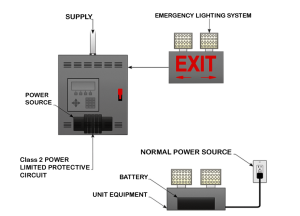How are Class 2 Emergency Lighting Systems wired according to the 2023 NEC?
Overview
Recent advancements in Class 2 power handling technologies have brought forth innovations in low-voltage power systems, including Power over Ethernet (PoE) and low-power consumption LED luminaires. These technologies are designed with inherent protection against electrical hazards, such as electric shock or fire. Due to their limited power and current levels, the risk of injury or damage in case of a fault is significantly reduced. To accommodate the increasing adoption of these technologies across various industries, the NEC 2023 introduced a new Section 700.11, which outlines the wiring requirements for such lighting systems. This section mandates that all wiring must be permanently marked, different types of cables must be separated based on their applications, and the wiring must be protected using raceways and conduits.
hazards, such as electric shock or fire. Due to their limited power and current levels, the risk of injury or damage in case of a fault is significantly reduced. To accommodate the increasing adoption of these technologies across various industries, the NEC 2023 introduced a new Section 700.11, which outlines the wiring requirements for such lighting systems. This section mandates that all wiring must be permanently marked, different types of cables must be separated based on their applications, and the wiring must be protected using raceways and conduits.
Applying the 2023 Code
Emergency lighting systems (ELS) are essential for illuminating escape routes, stairwells, and critical areas during power failures or emergencies. They are crucial for ensuring the safety of occupants and providing clear visibility and guidance for quick and orderly evacuations. Class-2 powered ELS, which utilize power over Ethernet (PoE) for power delivery and low-power consumption LED luminaires, are rapidly growing across industries. This is due to their numerous advantages over traditional lighting methods, including lightweight design, energy efficiency, minimal maintenance requirements, ease of use, and the ability to use remote applications.
Previous NEC editions did not address the installation requirements for Class-2 powered emergency lighting systems (ELS). However, with the introduction of Section 700.11 in the NEC 2023 edition, there are now specific guidelines for the installation of this technology. This section stipulates that all wiring used in Class-2 ELS systems must be permanently marked, different types of cables must be separated according to their applications, and the wiring must be protected using raceways and conduits. This new section aims to standardize the installation and usage of Class 2-powered emergency lighting systems.
What’s New for the 2023 NEC?
The table below presents a comparison between the 2020 NEC and the 2023 NEC regarding Section 700.11.
2020 NEC |
2023 NEC |
| In the 2020 NEC, no reference or installation guidelines can be found for Wiring, Class-2-Powered Emergency Lighting Systems. | 700.11 Wiring, Class-2-Powered Emergency Lighting Systems
(A) General Line voltage supply wiring and installation of Class 2 emergency lighting control devices shall comply with 700.10. Class 2 emergency circuits shall comply with 700.11 (B) through (D). (B) Identification Emergency circuits shall be permanently marked so they will be readily identified as a component of an emergency circuit or system by the following methods: All boxes and enclosures for Class 2 emergency circuits shall be permanently marked as a component of an emergency circuit or system. Exposed cable, cable tray, or raceway systems shall be permanently marked to be identified as a component of an emergency circuit or system, within 900 mm (3 ft) of each connector and at intervals not to exceed 7.6 m (25 ft). (C) Separation of Circuits Class 2 emergency circuits shall be wired in a listed, jacketed cable or with one of the wiring methods of Chapter 3. If installed alongside nonemergency Class 2 circuits that are bundled, Class 2 emergency circuits shall be bundled separately. If installed alongside nonemergency Class 2 circuits that are not bundled, Class 2 emergency circuits shall be separated by a nonconductive sleeve or nonconductive barrier from all other Class 2 circuits. Separation from other circuits shall comply with 725.136. (D) Protection Wiring shall comply with the requirements of 300.4 and be installed in a raceway, armored or metal-clad cable, or cable tray. Exception No. 1: Section 700.11(D) shall not apply to wiring that does not exceed 1.83 m (6 ft) in length and that terminates at an emergency luminaire or an emergency lighting control device. Exception No. 2: Section 700.11(D) shall not apply to locked rooms or locked enclosures that are accessible only to qualified persons. Informational Note: Locked rooms accessible only to qualified persons include locked telecommunications rooms, locked electrical equipment rooms, or other access-controlled areas. |
